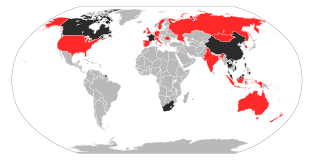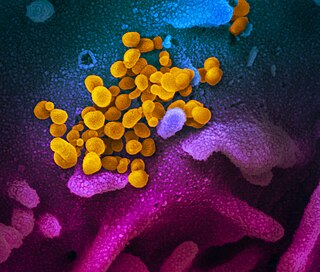Related Research Articles

Severe acute respiratory syndrome (SARS) is a viral respiratory disease of zoonotic origin caused by severe acute respiratory syndrome coronavirus, the first-identified strain of the SARS coronavirus species severe acute respiratory syndrome-related coronavirus (SARSr-CoV). The syndrome caused the 2002–2004 SARS outbreak. In late 2017, Chinese scientists traced the virus through the intermediary of Asian palm civets to cave-dwelling horseshoe bats in Yunnan.

The 2002–2004 SARS outbreak was an epidemic involving severe acute respiratory syndrome (SARS) caused by severe acute respiratory syndrome coronavirus. The outbreak was first identified in Foshan, Guangdong, China, on 16 November 2002.

Severe acute respiratory syndrome coronavirus is a strain of virus that causes severe acute respiratory syndrome (SARS). It is an enveloped, positive-sense, single-stranded RNA virus which infects the epithelial cells within the lungs. The virus enters the host cell by binding to angiotensin-converting enzyme 2. It infects humans, bats, and palm civets.
This is a shortened version of the tenth chapter of the ICD-10: Diseases of the respiratory system. It covers ICD codes J00 to J99. All versions of the ICD-10, including the most recent one (2019), can be browsed freely on the website of the World Health Organisation (WHO). The ICD-10 can also be downloaded in PDF-form.
Novel coronavirus (nCoV) is a provisional name given to coronaviruses of medical significance before a permanent name is decided upon. Although coronaviruses are endemic in humans and infections normally mild, such as the common cold, cross-species transmission has produced some unusually virulent strains which can cause viral pneumonia and in serious cases even acute respiratory distress syndrome and death.

Remdesivir, sold under the brand name Veklury, is a broad-spectrum antiviral medication developed by the biopharmaceutical company Gilead Sciences. It is administered via injection into a vein. Remdesivir is being tested as a treatment for COVID‑19, and has been authorized for emergency use in the US, India, Singapore, and approved for use in Japan, the European Union, and Australia for people with severe symptoms. It also received approval in the UK in May 2020; however, it was going to be rationed due to limited supply. It may shorten the time it takes to recover from the infection.

Disease X is a placeholder name that was adopted by the World Health Organization (WHO) in February 2018 on their shortlist of blueprint priority diseases to represent a hypothetical, unknown pathogen that could cause a future epidemic. The WHO adopted the placeholder name to ensure that their planning was sufficiently flexible to adapt to an unknown pathogen. Director of the US National Institute of Allergy and Infectious Diseases Anthony Fauci stated that the concept of Disease X would encourage WHO projects to focus their research efforts on entire classes of viruses, instead of just individual strains, thus improving WHO capability to respond to unforeseen strains. In 2020, it was speculated, including among some of the WHO's own expert advisors, that COVID-19, caused by SARS-CoV-2 virus strain, met the requirements to be the first Disease X.
Vaping-associated pulmonary injury (VAPI) also known as vaping-associated lung injury (VALI) or e-cigarette, or vaping, product use associated lung injury (E/VALI), is a lung disease associated with the use of vaping products that can be severe and life-threatening. Symptoms can initially mimic common pulmonary diagnoses like pneumonia, but individuals typically do not respond to antibiotic therapy. Individuals usually present for care within a few days to weeks of symptom onset.

Severe acute respiratory syndrome coronavirus 2 (SARS-CoV-2) is the strain of coronavirus that causes coronavirus disease 2019 (COVID-19), the respiratory illness responsible for the COVID-19 pandemic. Colloquially known as simply the coronavirus, it was previously referred to by its provisional name, 2019 novel coronavirus (2019-nCoV), and has also been called human coronavirus 2019. The World Health Organization declared the outbreak a Public Health Emergency of International Concern on 30 January 2020, and a pandemic on 11 March 2020.

A coronavirus disease, coronavirus respiratory syndrome, coronavirus pneumonia, coronavirus flu, or any other variant, is a disease caused by members of the coronavirus (CoV) family.

Coronavirus disease 2019 (COVID-19) is an infectious disease caused by severe acute respiratory syndrome coronavirus 2 (SARS-CoV-2). It was first identified in December 2019 in Wuhan, Hubei, China, and has resulted in an ongoing pandemic. The first confirmed case has been traced back to 17 November 2019 in Hubei. As of 29 July 2020, more than 16.7 million cases have been reported across 188 countries and territories, resulting in more than 660,000 deaths. More than 9.76 million people have recovered.

Dale Andrew Fisher FRACP is an Australian physician who specialises in Infectious Diseases and is a Senior Consultant in the Division of Infectious Diseases at the National University Hospital, Singapore. He is also a Professor of Medicine at the Yong Loo Lin School of Medicine, National University of Singapore, the chair of the National Infection Prevention and Control Committee through the Ministry of Health, Singapore, and chair of the steering committee of the Global Outbreak Alert and Response Network hosted by the World Health Organization.

The COVID-19 pandemic in Poland is part of the worldwide pandemic of coronavirus disease 2019 caused by severe acute respiratory syndrome coronavirus 2. In February and March 2020, health authorities in Poland carried out laboratory testing of suspected cases of infection by SARS-CoV-2, one of the seven known human coronaviruses, as well as home quarantining and monitoring. The first case of a laboratory confirmed SARS-CoV-2 infection in Poland was that of a man hospitalised in Zielona Góra, with confirmation announced officially on 4 March 2020. The local transmission phase of SARS-CoV-2 in Poland was declared to the World Health Organization on 10 March. The first death from coronavirus disease 2019 (COVID-19) in Poland was that of a 56-year-old woman on 12 March. Polish authorities did not participate in the 28 February 2020 European Union tender procedure for purchasing COVID-19 pandemic related medical equipment, in which 20 other member states participated. Poland applied on 6 March for the 17 March tender for the purchase of gloves, goggles, face shields, surgical masks and protective clothing; the European Commission stated that all requests in the tender were satisfied by offers.

The COVID-19 pandemic in Moldova is part of the worldwide pandemic of coronavirus disease 2019 caused by severe acute respiratory syndrome coronavirus 2. The virus was confirmed to have reached the Republic of Moldova on 7 March 2020, when a Moldovan woman that returned from Italy was tested positive for the novel coronavirus. As the number of infected people started to rise during the next days, on 17 March 2020 the Parliament declared the state of emergency for the entire territory of the Republic of Moldova for a period of 60 days. On 18 March 2020 the first death caused by COVID-19 was registered. On 23 March 2020 the total number of confirmed cases surpassed 100 and on 7 April 2020 this number exceeded 1000. By 10 April 2020, cases had been confirmed in all the regions of the country, including the transnistrian region. On 27 April 2020, the total number of deaths surpassed 100.
The COVID-19 pandemic in Armenia is part of the worldwide pandemic of coronavirus disease 2019 caused by severe acute respiratory syndrome coronavirus 2. The virus was confirmed to have reached Armenia on 1 March 2020 when its first case was reported. The disease, coronavirus disease 2019, caused by a novel virus known as severe acute respiratory syndrome coronavirus 2, has spread to all of the regions (marz) of Armenia and has caused 719 deaths.

The COVID-19 pandemic in Panama is part of the worldwide pandemic of coronavirus disease 2019 caused by severe acute respiratory syndrome coronavirus 2. The virus was confirmed to have spread to Panama on 9 March 2020. One of the dead was a 64-year-old male, who also suffered from complications of diabetes and pneumonia. Of those infected, 83 were admitted to hospital. The infected individuals belong to the 29-59 age group and had each recently travelled abroad. A 13-year-old girl died of COVID-19 on 23 March. As of 28 July 2020, Panama reported 62,223 cases, 1,349 deaths, and 36,181 recoveries.

COVID-19 surveillance involves monitoring the spread of the coronavirus disease in order to establish the patterns of disease progression. The World Health Organization (WHO) recommends active surveillance, with focus of case finding, testing and contact tracing in all transmission scenarios. COVID-19 surveillance is expected to monitor epidemiological trends, rapidly detect new cases, and based on this information, provide epidemiological information to conduct risk assessment and guide disease preparedness.
Samira Mubareka is a Canadian microbiologist who is a clinical scientist at the Sunnybrook Health Sciences Centre in Toronto, Ontario. Her research considers the influenza virus, viral transmission and aerobiology. During the COVID-19 pandemic Mubareka isolated the genome of Severe Acute Respiratory Syndrome COronaVirus 2 (SARS-CoV-2) in an effort to improve detection and diagnostics.
Carolyn S. Calfee is a Professor of Medicine and Anaesthesia at the University of California, San Francisco. She works in intensive care at the UCSF Medical Center where she specialises in acute respiratory distress syndrome. During the COVID-19 pandemic Calfee studied why SARS-CoV-2 patients experienced such different symptoms.
Management of COVID-19 includes supportive care, which may include fluid therapy, oxygen support, and supporting other affected vital organs. The WHO is in the process of including dexamethasone in guidelines for treatment for hospitalized patients, and it is recommended for consideration in Australian guidelines for patients requiring oxygen. CDC recommends those who suspect they carry the virus wear a simple face mask. Extracorporeal membrane oxygenation (ECMO) has been used to address the issue of respiratory failure, but its benefits are still under consideration. Personal hygiene and a healthy lifestyle and diet have been recommended to improve immunity. Supportive treatments may be useful in those with mild symptoms at the early stage of infection.
References
- ↑ "U00-U49 – ICD-10 Version:2019". World Health Organization. 2019. Retrieved 4 April 2020.
- ↑ "New ICD-10-CM code for vaping-related disorder to be implemented April 1, 2020" (PDF). Centers for Disease Control and Prevention. 12 September 2019.
- ↑ "New ICD-10-CM code for the 2019 Novel Coronavirus (COVID-19), April 1, 2020" (PDF). Centers for Disease Control and Prevention. 18 March 2020.
- ↑ "List of Official ICD-10 Updates". World Health Organization. COVID-19 update for ICD-10. Retrieved 3 April 2020.
- ↑ "U07.1 – ICD-10 Version:2019". World Health Organization. 2019. Archived from the original on 31 March 2020. Retrieved 31 March 2020.
U07.2 – COVID-19, virus not identified – COVID-19 NOS – Use this code when COVID-19 is diagnosed clinically or epidemiologically but laboratory testing is inconclusive or not available. Use additional code, if desired, to identify pneumonia or other manifestations